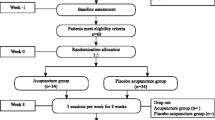Abstract
Chronic prostatitis/chronic pelvic pain syndrome (CP/ CPPS) is prevalent in urological practice and has a significant impact on quality of life. Standard therapies often fail to achieve sustainable amelioration of symptoms. This article attempts to show that neuromodulatory treatment in the form of electroacupuncture can be a minimally invasive and effective treatment for CP/CPPS that is refractory to standard therapies. This neuromodulatory therapy lends support to the hypothesis that the end stage of CP/CPPS may be a neuropathic pain syndrome.
Similar content being viewed by others
References and Recommended Reading
Nickel JC: Prostatitis and related conditions. In Campbell’s Urology, edn 8. Edited by Walsh PC, Retik AB, Vaughan ED Jr. Philadelphia: W.B. Saunders; 2002:603–630.
Nickel JC: The three A’s of chronic prostatitis therapy: antibiotics, alpha-blockers, and anti-inflammatories: What is the evidence? BJU Int 2004, in press.
Gun CC: Neuropathic pain: a new theory for chronic pain of intrinsic origin. Ann R Coll Physicians Surg Can 1989, 22:327–330.
Yuting C: Clinical observation on combined treatment of 360 cases of prostatitis with acupuncture of Sishenchong Point and self-drafted prescription I, II and III. World J Acupunct Moxibustion 2000, 10:1–4.
Katai S: Effect of electric acupuncture therapy on chronic prostatitis. Bull Juntendou Univ 1992, 38:210–219.
Ikeuchi T, Iguchi H: Clinical studies on chronic prostatitis and prostatitis-like syndrome: electric acupuncture therapy for intractable cases of chronic prostatitis-like syndrome. Hinyokika Kiyo 1994, 40:587–591.
Chen C, Gao Z, Liu Y, Shen L: Treatment of chronic prostatitis with laser acupuncture. J Tradit Chin Med 1995, 15:38–41.
Ge SH, Mang FY, Xu BR: Acupuncture treatment in 102 cases of chronic prostatitis. J Tradit Chin Med 1988, 8:99–100.
Chen RC, Nickel JC: Acupuncture ameliorates symptoms in men with chronic prostatitis and chronic pelvic pain syndrome. Adult Urol 2003, 61:1156–1159.
Krieger JN, Nyberg L, Nickel JC: NIH consensus definition and classification of prostatitis. JAMA 1999, 282:236–237.
Litwin SM, McNaughton-Collins M, Fowler FJ, et al.: The NIH Chronic Prostatitis Symptom Index (NIH-CPSI): development and validation of a new outcomes measure. J Urol 1999, 162:369–375.
Price DD, Mayer DJ: Evidence for endogenous opiate analgesic mechanism and triggers by somatosensory stimulation (include acupuncture) in humans. PAIS Forum 1995, 4:40–43.
Stux G, Pomeranz B: Basics of Acupuncture, edn 4. New York: Springer; 1998.
Cheng RS, Pomeranz B: Electroacupuncture analgesia could be medicated by at least two pain-relieving mechanisms: endorphin and nonendorphin system. Life Sci 1979, 25:1957–1962.
Cheng RS: Dexamethasone partially reduces 2% saline abolishes electro acupuncture analgesic, and these finding implicate pituitary endorphin. Life SCT 1979, 24:1481–1486.
Cheng RS: Mechanism of electro acupuncture analgesic on intricate system is proposed. In PhD Thesis. Toronto: University of Toronto; 1981.
Helms JM: Chapter II. In Acupuncture Energetics and Clinical Approach for Physicians. California: Medical Acupuncture Publisher; 1995: 31–36.
De Groot WC: Anatomy of the central neural pathways controlling the lower urinary tract. Eur Urol 1998, 34(suppl 1):2–5.
Han JS, Tereniu H: Neurochemical basis of acupuncture analgesic. Annu Rev Pharmacol Toxicol 1982, 22:193–200.
Vacca-Galloway LL, Naftchi NE, Arakawa K, et al.: Alteration of immunoreactive substance P and enkephalin in rate spinal cord after electroacupuncture. Peptides 1985, 6(suppl 1):177–188.
Chang RS, Pomeranz B: A combined treatment with D-amino acids and electroacupuncture produces a greater analgesia then either treatment alone: naloxone reverses these effects. Pain 1980, 8:231–236.
Mezey E, Palkovits M, de Kloet ER, et al.: Evidence for pituitary-brain transport of a behaviorally potent ACTH analog. Life Sci 1978, 22:831–838.
Bergland RM, Page RB: Pituitary-brain vascular relations: a new paradigm. Science 1979, 204:18–24.
Tsou K, Wu SH, Wan FS, et al.: Increased levels of endorphins in the cisteral cerebrospinal fluid of rabbits in acupuncture analgesia. Act Physiologic Sinica 1979, 31:371–376.
Zermann DH, Ishigooka M, Schmidt R: Pathophysiology of the hypertonic sphincter or hyperpathic urethra. In The Urinary Sphincter. Edited by Corcos J, Schick E. New York: Marcel Dekker; 2001:201–205. This article is instructive and comprehensive. It supports the hypothesis that neuromodulatory treatments for CP/CPPS could be beneficial.
Zhang ZY, Zhang K: Effect of acupuncture on the pons micturition centre and the related function of the urinary bladder. Zhen Ci Yan Jiu 1987, 12:116–122.
Pomeranz B, Cheng R: Suppression of noxious responses in single neurons of cat spinal cord by electroacupuncture and its reversal by the opiate antagonist naloxone. Exp Neurol 1979, 64:327–341.
Basbaum AI, Fields HL: Endogenous pain control mechanism: review and hypothesis. Ann Neurol 1978, 4:451–462.
Yaksh TL, Wilson PR: Spinal serotonin terminal system medicates antinociception. J Pharmacol Exp Ther 1979, 208:446–453.
Rosenfeld JP: Interacting brain stem components of opiateactivated descending pain inhibitory system. Neurosci Biobehav Rev 1994, 18:403–409.
Yi CC, Lu TH, Wu SH, Tsou K: A study of the release of H (37 S-Hydroxytryptamine from brain during acupuncture and morphine analgesia. Sci Sin 1977, 20:113–124.
Han CS, Shou PH, Lu CC, et al.: The role of central S-hydroxytryptamine in acupuncture analgesia. Sci Sin 1979, 22:91–104.
Espey MJ, Du HJ, Downie JW: Serotonergic modulation of spinal ascending activity and sacral reflex activity evoked by pelvic nerve stimulation in cats. Brain Res 1988, 798:101–108.
Dmochowski RR, Miklos JR, Norton PA, et al.: Duloxetine versus placebo for the treatment of North American women with stress urinary incontinence. J Urol 2003, 170:1259–1263.
Thor KB: Neurology: exploring new horizons and advanced studies. John Hopkins Med J 2002, 2:677–680.
Shoskes DA, Albakri Q, Thomas K, Cook D: Cytokine polymorphisms in men with chronic prostatitis/chronic pelvic pain syndrome: association with diagnosis and treatment response. J Urol 2002, 168:331–335. This article postulates a hypothesis that men with CP/CPPS may have a genetic predisposition to inflammation or autoimmunity.
Schmidt RA: Pelvic pain. Prob Urol 1989, 3:270–280.
Codeere TJ, Katz J, Vaccarino A, Melzack R: Contribution of central neuroplasticity to pathological pain: review of clinical and experimental evidence. Pain 1993, 52:259–285.
Author information
Authors and Affiliations
Rights and permissions
About this article
Cite this article
Chen, R.C.T., Nickel, J.C. Acupuncture for chronic prostatitis/ chronic pelvic pain syndrome. Curr Urol Rep 5, 305–308 (2004). https://doi.org/10.1007/s11934-004-0057-z
Issue Date:
DOI: https://doi.org/10.1007/s11934-004-0057-z




